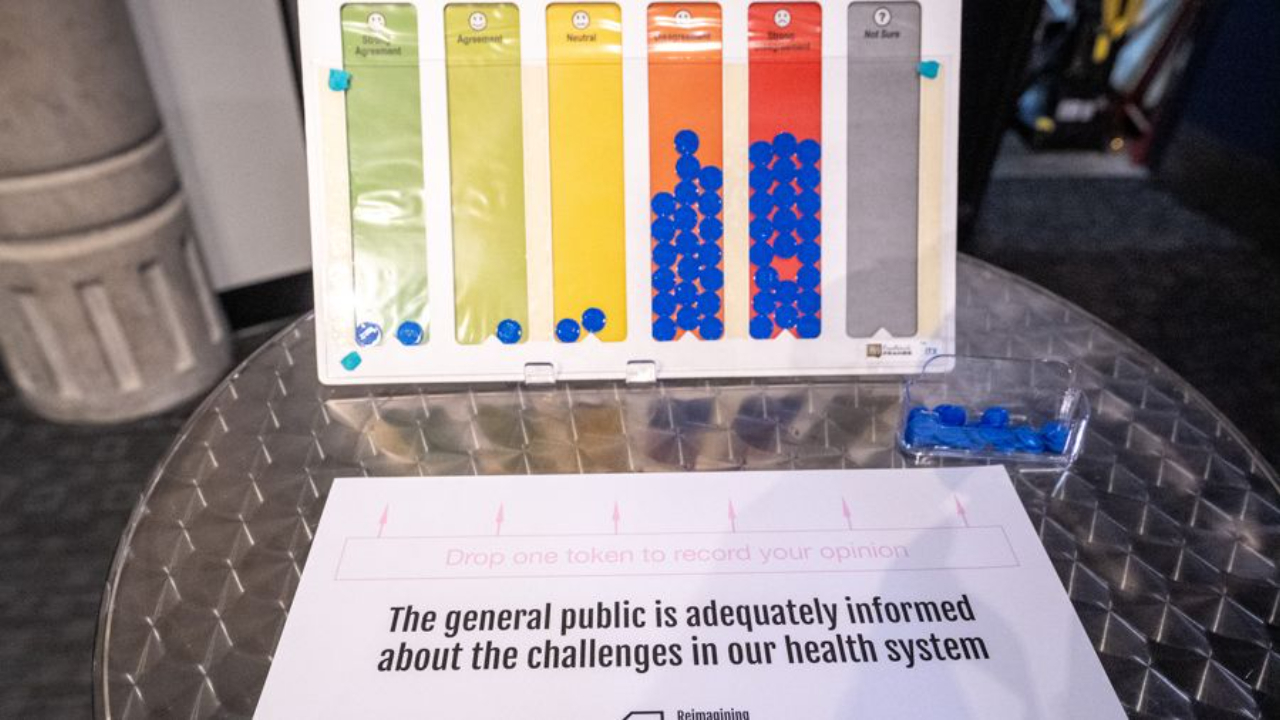How Well Does the Public Understand the Challenges in Our Health Care System?

Picture this: You're standing at a podium during your hospital's annual community meeting. The room is packed with engaged citizens, local media, and community leaders. You're explaining the complex reasons behind emergency department wait times, but as you scan the room, you see furrowed brows and skeptical expressions. Despite your clear explanation, there's a palpable disconnect between your understanding of the challenges and how your audience perceives them.
If this scenario feels familiar, you're experiencing a phenomenon that's becoming increasingly common across Canadian health care leadership. And it's not just your imagination – the data tells a compelling story about this growing disconnect between health care leaders and the public we serve.
In our poll at Reimagining Health Care Leadership, 83.9% either disagreed (38.7%) or strongly disagreed (45.2%) with the following statement, “The general public is adequately informed about the challenges in our health system.”
The Real-World Impact on Leadership
This understanding gap creates tangible challenges for health care leaders:
- Change Management Obstacles
- Public resistance to necessary system changes due to misunderstanding of current challenges
- Difficulty building community support for innovative solutions
- Increased time spent addressing misconceptions rather than implementing improvements
- Trust and Credibility Issues
- Erosion of public confidence in institutions
- Challenges in maintaining staff morale when public criticism is based on misconceptions
- Difficulty building partnerships with community organizations
- Resource Allocation Challenges
- Public pressure for solutions that may not address root causes
- Resistance to evidence-based changes due to misconceptions
- Difficulty explaining trade-offs and priority-setting decisions
Leading Through the Gap: A Strategic Approach
As a health care leader, you have the responsibility and the opportunity to bridge this understanding gap. Here's a comprehensive approach to tackling this challenge:
- Simplify Without Oversimplifying
- Break down complex challenges into digestible pieces
- Use real-world examples that resonate with public experience
- Create visual representations of system interconnections
- Develop clear narratives that illustrate cause and effect
- Use metaphors and analogies that make complex concepts more accessible
- Engage Authentically and Consistently
- Share both challenges and successes transparently
- Create regular opportunities for community dialogue
- Build relationships with local media to ensure more comprehensive coverage
- Establish ongoing feedback mechanisms
- Maintain consistent presence in community forums
- Empower Your Organization
- Equip staff at all levels to be system ambassadors
- Develop clear, consistent messaging about key challenges
- Create internal communication channels to share public feedback
- Celebrate successful public engagement initiatives
- Provide communication training for key staff members
Practical Implementation Steps
Start by conducting a thorough audit of your organization's current public communication approach:
- Assessment Phase
- Review current communication materials for clarity and accessibility
- Survey staff about common public misconceptions they encounter
- Analyze social media and traditional media coverage
- Gather feedback from community partners
- Evaluate the effectiveness of existing public engagement initiatives
- Development Phase
- Create a library of clear, jargon-free explanations for common system challenges
- Develop a regular "Community Conversation" series
- Design visual aids to explain complex system interactions
- Establish metrics to measure public understanding
- Create a rapid response protocol for addressing misconceptions
- Implementation Phase
- Launch targeted education initiatives
- Partner with local community organizations
- Establish regular media briefing sessions
- Create opportunities for two-way dialogue
- Monitor and measure impact
Measuring Success
Implement these key metrics to track your progress:
- Public understanding surveys before and after engagement initiatives
- Media coverage analysis for accuracy and comprehensiveness
- Social media sentiment tracking
- Community feedback session outcomes
- Staff reports of public interaction quality
- Partnership effectiveness measures
The Power of Small Wins
Remember that changing public understanding is a marathon, not a sprint. Look for and celebrate small wins along the way:
- A community member who becomes an advocate after understanding a complex issue
- A local media outlet that begins providing more nuanced coverage
- Staff members who report more productive conversations with the public
- Community partners who actively help explain system challenges
- Successful implementation of changes due to better public understanding
Looking to the Future
This isn't just a challenge – it's an unprecedented opportunity to build stronger connections with our communities and create more informed support for necessary system changes.
Your role as a health care leader extends beyond managing services and programs. You're building the understanding that will make positive change possible. You're creating the foundation for a more informed and engaged public that can partner with us in improving our health care system.
The Path Forward
The next time you stand before your community to explain a complex challenge, remember: you're not just sharing information – you're building bridges of understanding that will support better health care for all Canadians. Every major advance in health care began with helping people understand why change was necessary.
Remember, it's not about having all the answers. It's about asking the right questions, fostering meaningful dialogue, and bringing your community along on the journey toward better health care for all Canadians. The understanding gap is real, but so is our ability to bridge it – one conversation, one explanation, and one engaged citizen at a time.
Subscribe to our newsletter for Health Care Leaders and get a FREE copy of our book!
We don't email often.
When we do, we contribute value.
If you don't see the value, we make it easy to unsubscribe.

